Analysis of John Lewis Ltd Business Strategy and Recommendations
VerifiedAdded on 2023/01/23
|10
|2608
|72
Report
AI Summary
This report provides a comprehensive analysis of John Lewis Ltd's business strategy. It begins with an introduction to business strategy and then delves into an overview of the company. The report includes a PESTLE analysis, examining political, economic, social, technological, legal, and environmental factors affecting the company. A SWOT analysis is also presented, outlining the company's strengths, weaknesses, opportunities, and threats. Furthermore, the report utilizes Porter's Five Forces model to analyze the competitive environment. It then explores different types of strategic directions available to the company, with a recommendation for the most appropriate growth platform, focusing on low pricing strategy. Finally, the report outlines a strategic management plan, including tactics, objectives, and strategies designed to enhance the company's competitive advantage in the UK market.
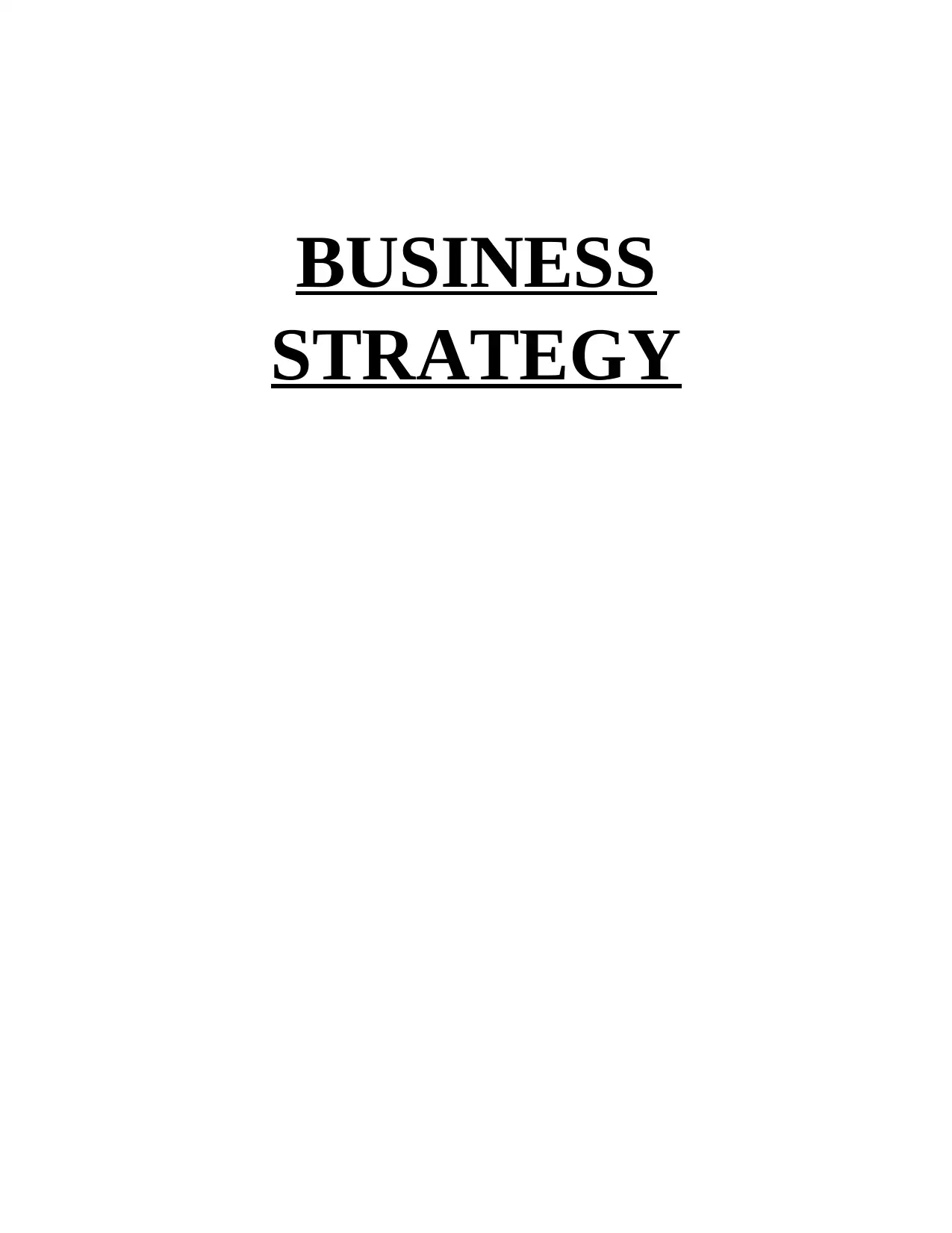
BUSINESS
STRATEGY
STRATEGY
Paraphrase This Document
Need a fresh take? Get an instant paraphrase of this document with our AI Paraphraser
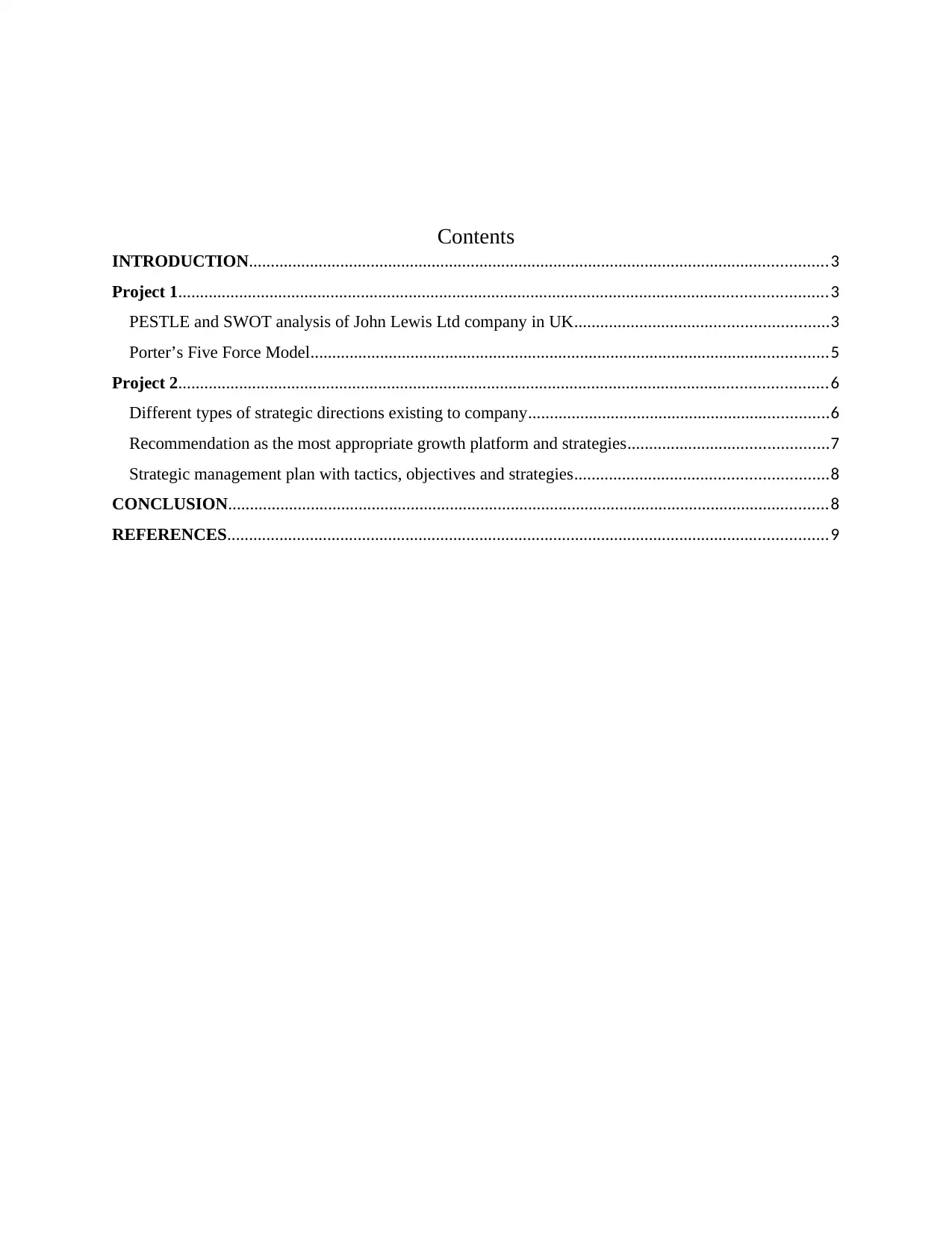
Contents
INTRODUCTION.....................................................................................................................................3
Project 1.....................................................................................................................................................3
PESTLE and SWOT analysis of John Lewis Ltd company in UK..........................................................3
Porter’s Five Force Model.......................................................................................................................5
Project 2.....................................................................................................................................................6
Different types of strategic directions existing to company.....................................................................6
Recommendation as the most appropriate growth platform and strategies..............................................7
Strategic management plan with tactics, objectives and strategies..........................................................8
CONCLUSION..........................................................................................................................................8
REFERENCES..........................................................................................................................................9
INTRODUCTION.....................................................................................................................................3
Project 1.....................................................................................................................................................3
PESTLE and SWOT analysis of John Lewis Ltd company in UK..........................................................3
Porter’s Five Force Model.......................................................................................................................5
Project 2.....................................................................................................................................................6
Different types of strategic directions existing to company.....................................................................6
Recommendation as the most appropriate growth platform and strategies..............................................7
Strategic management plan with tactics, objectives and strategies..........................................................8
CONCLUSION..........................................................................................................................................8
REFERENCES..........................................................................................................................................9
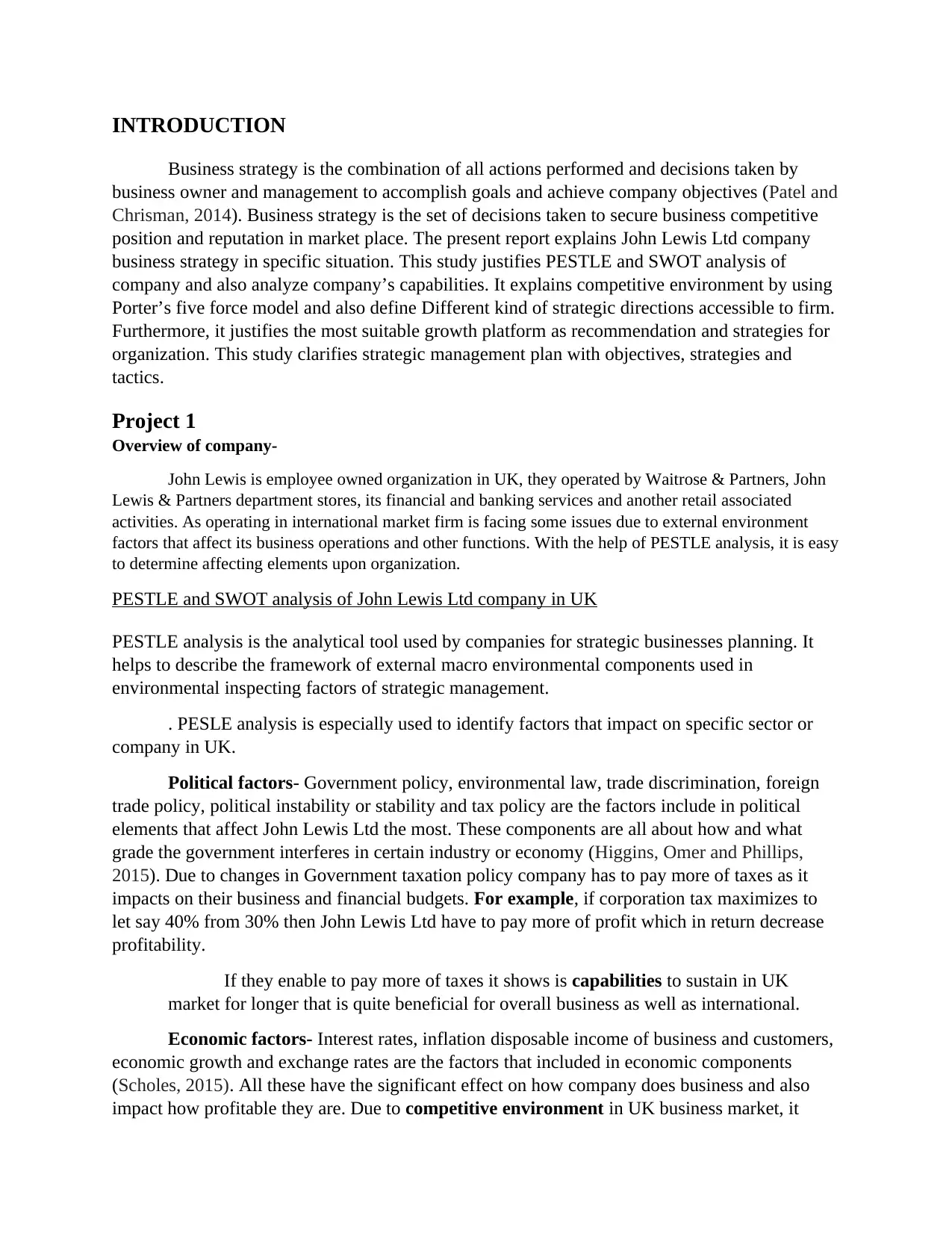
INTRODUCTION
Business strategy is the combination of all actions performed and decisions taken by
business owner and management to accomplish goals and achieve company objectives (Patel and
Chrisman, 2014). Business strategy is the set of decisions taken to secure business competitive
position and reputation in market place. The present report explains John Lewis Ltd company
business strategy in specific situation. This study justifies PESTLE and SWOT analysis of
company and also analyze company’s capabilities. It explains competitive environment by using
Porter’s five force model and also define Different kind of strategic directions accessible to firm.
Furthermore, it justifies the most suitable growth platform as recommendation and strategies for
organization. This study clarifies strategic management plan with objectives, strategies and
tactics.
Project 1
Overview of company-
John Lewis is employee owned organization in UK, they operated by Waitrose & Partners, John
Lewis & Partners department stores, its financial and banking services and another retail associated
activities. As operating in international market firm is facing some issues due to external environment
factors that affect its business operations and other functions. With the help of PESTLE analysis, it is easy
to determine affecting elements upon organization.
PESTLE and SWOT analysis of John Lewis Ltd company in UK
PESTLE analysis is the analytical tool used by companies for strategic businesses planning. It
helps to describe the framework of external macro environmental components used in
environmental inspecting factors of strategic management.
. PESLE analysis is especially used to identify factors that impact on specific sector or
company in UK.
Political factors- Government policy, environmental law, trade discrimination, foreign
trade policy, political instability or stability and tax policy are the factors include in political
elements that affect John Lewis Ltd the most. These components are all about how and what
grade the government interferes in certain industry or economy (Higgins, Omer and Phillips,
2015). Due to changes in Government taxation policy company has to pay more of taxes as it
impacts on their business and financial budgets. For example, if corporation tax maximizes to
let say 40% from 30% then John Lewis Ltd have to pay more of profit which in return decrease
profitability.
If they enable to pay more of taxes it shows is capabilities to sustain in UK
market for longer that is quite beneficial for overall business as well as international.
Economic factors- Interest rates, inflation disposable income of business and customers,
economic growth and exchange rates are the factors that included in economic components
(Scholes, 2015). All these have the significant effect on how company does business and also
impact how profitable they are. Due to competitive environment in UK business market, it
Business strategy is the combination of all actions performed and decisions taken by
business owner and management to accomplish goals and achieve company objectives (Patel and
Chrisman, 2014). Business strategy is the set of decisions taken to secure business competitive
position and reputation in market place. The present report explains John Lewis Ltd company
business strategy in specific situation. This study justifies PESTLE and SWOT analysis of
company and also analyze company’s capabilities. It explains competitive environment by using
Porter’s five force model and also define Different kind of strategic directions accessible to firm.
Furthermore, it justifies the most suitable growth platform as recommendation and strategies for
organization. This study clarifies strategic management plan with objectives, strategies and
tactics.
Project 1
Overview of company-
John Lewis is employee owned organization in UK, they operated by Waitrose & Partners, John
Lewis & Partners department stores, its financial and banking services and another retail associated
activities. As operating in international market firm is facing some issues due to external environment
factors that affect its business operations and other functions. With the help of PESTLE analysis, it is easy
to determine affecting elements upon organization.
PESTLE and SWOT analysis of John Lewis Ltd company in UK
PESTLE analysis is the analytical tool used by companies for strategic businesses planning. It
helps to describe the framework of external macro environmental components used in
environmental inspecting factors of strategic management.
. PESLE analysis is especially used to identify factors that impact on specific sector or
company in UK.
Political factors- Government policy, environmental law, trade discrimination, foreign
trade policy, political instability or stability and tax policy are the factors include in political
elements that affect John Lewis Ltd the most. These components are all about how and what
grade the government interferes in certain industry or economy (Higgins, Omer and Phillips,
2015). Due to changes in Government taxation policy company has to pay more of taxes as it
impacts on their business and financial budgets. For example, if corporation tax maximizes to
let say 40% from 30% then John Lewis Ltd have to pay more of profit which in return decrease
profitability.
If they enable to pay more of taxes it shows is capabilities to sustain in UK
market for longer that is quite beneficial for overall business as well as international.
Economic factors- Interest rates, inflation disposable income of business and customers,
economic growth and exchange rates are the factors that included in economic components
(Scholes, 2015). All these have the significant effect on how company does business and also
impact how profitable they are. Due to competitive environment in UK business market, it
⊘ This is a preview!⊘
Do you want full access?
Subscribe today to unlock all pages.

Trusted by 1+ million students worldwide
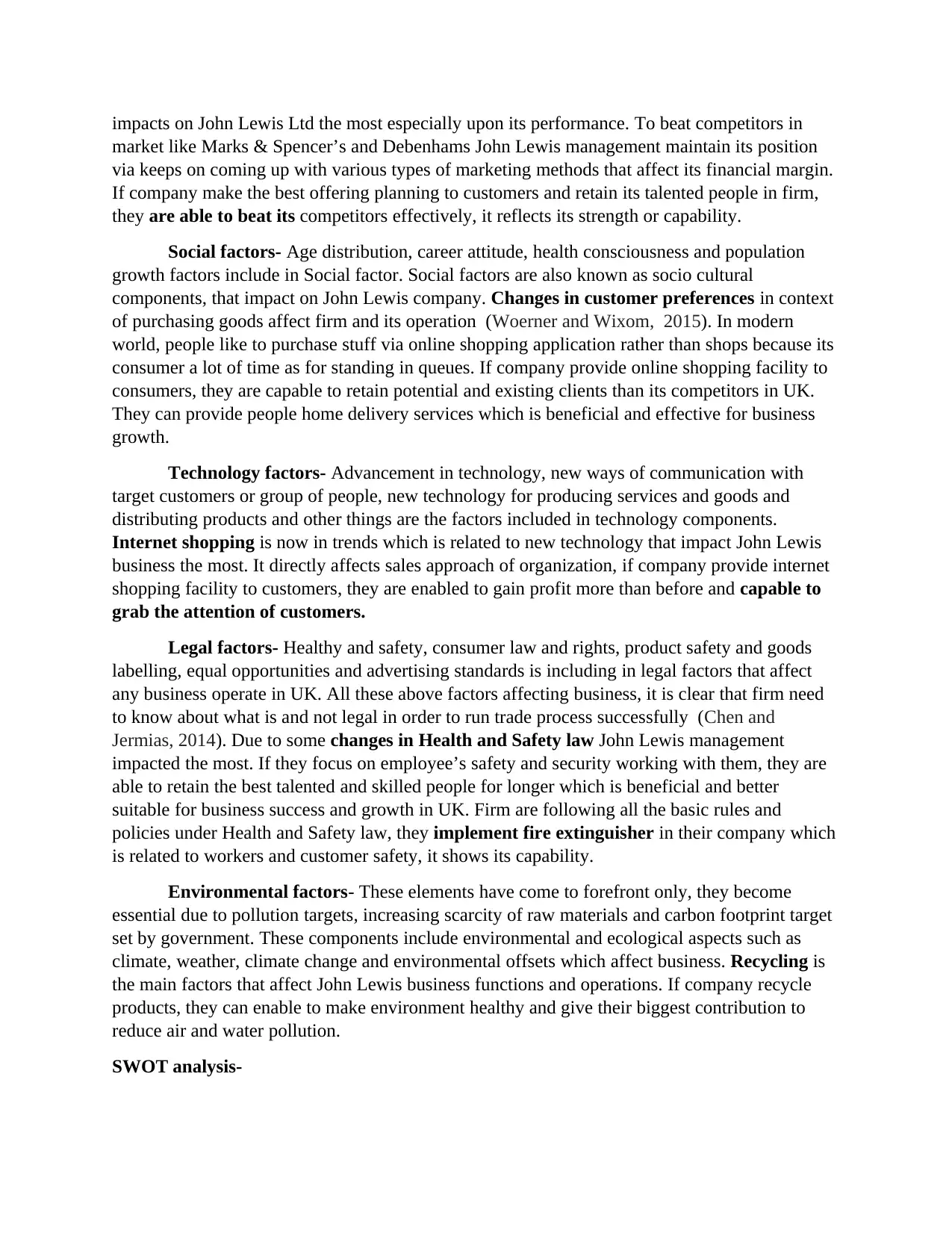
impacts on John Lewis Ltd the most especially upon its performance. To beat competitors in
market like Marks & Spencer’s and Debenhams John Lewis management maintain its position
via keeps on coming up with various types of marketing methods that affect its financial margin.
If company make the best offering planning to customers and retain its talented people in firm,
they are able to beat its competitors effectively, it reflects its strength or capability.
Social factors- Age distribution, career attitude, health consciousness and population
growth factors include in Social factor. Social factors are also known as socio cultural
components, that impact on John Lewis company. Changes in customer preferences in context
of purchasing goods affect firm and its operation (Woerner and Wixom, 2015). In modern
world, people like to purchase stuff via online shopping application rather than shops because its
consumer a lot of time as for standing in queues. If company provide online shopping facility to
consumers, they are capable to retain potential and existing clients than its competitors in UK.
They can provide people home delivery services which is beneficial and effective for business
growth.
Technology factors- Advancement in technology, new ways of communication with
target customers or group of people, new technology for producing services and goods and
distributing products and other things are the factors included in technology components.
Internet shopping is now in trends which is related to new technology that impact John Lewis
business the most. It directly affects sales approach of organization, if company provide internet
shopping facility to customers, they are enabled to gain profit more than before and capable to
grab the attention of customers.
Legal factors- Healthy and safety, consumer law and rights, product safety and goods
labelling, equal opportunities and advertising standards is including in legal factors that affect
any business operate in UK. All these above factors affecting business, it is clear that firm need
to know about what is and not legal in order to run trade process successfully (Chen and
Jermias, 2014). Due to some changes in Health and Safety law John Lewis management
impacted the most. If they focus on employee’s safety and security working with them, they are
able to retain the best talented and skilled people for longer which is beneficial and better
suitable for business success and growth in UK. Firm are following all the basic rules and
policies under Health and Safety law, they implement fire extinguisher in their company which
is related to workers and customer safety, it shows its capability.
Environmental factors- These elements have come to forefront only, they become
essential due to pollution targets, increasing scarcity of raw materials and carbon footprint target
set by government. These components include environmental and ecological aspects such as
climate, weather, climate change and environmental offsets which affect business. Recycling is
the main factors that affect John Lewis business functions and operations. If company recycle
products, they can enable to make environment healthy and give their biggest contribution to
reduce air and water pollution.
SWOT analysis-
market like Marks & Spencer’s and Debenhams John Lewis management maintain its position
via keeps on coming up with various types of marketing methods that affect its financial margin.
If company make the best offering planning to customers and retain its talented people in firm,
they are able to beat its competitors effectively, it reflects its strength or capability.
Social factors- Age distribution, career attitude, health consciousness and population
growth factors include in Social factor. Social factors are also known as socio cultural
components, that impact on John Lewis company. Changes in customer preferences in context
of purchasing goods affect firm and its operation (Woerner and Wixom, 2015). In modern
world, people like to purchase stuff via online shopping application rather than shops because its
consumer a lot of time as for standing in queues. If company provide online shopping facility to
consumers, they are capable to retain potential and existing clients than its competitors in UK.
They can provide people home delivery services which is beneficial and effective for business
growth.
Technology factors- Advancement in technology, new ways of communication with
target customers or group of people, new technology for producing services and goods and
distributing products and other things are the factors included in technology components.
Internet shopping is now in trends which is related to new technology that impact John Lewis
business the most. It directly affects sales approach of organization, if company provide internet
shopping facility to customers, they are enabled to gain profit more than before and capable to
grab the attention of customers.
Legal factors- Healthy and safety, consumer law and rights, product safety and goods
labelling, equal opportunities and advertising standards is including in legal factors that affect
any business operate in UK. All these above factors affecting business, it is clear that firm need
to know about what is and not legal in order to run trade process successfully (Chen and
Jermias, 2014). Due to some changes in Health and Safety law John Lewis management
impacted the most. If they focus on employee’s safety and security working with them, they are
able to retain the best talented and skilled people for longer which is beneficial and better
suitable for business success and growth in UK. Firm are following all the basic rules and
policies under Health and Safety law, they implement fire extinguisher in their company which
is related to workers and customer safety, it shows its capability.
Environmental factors- These elements have come to forefront only, they become
essential due to pollution targets, increasing scarcity of raw materials and carbon footprint target
set by government. These components include environmental and ecological aspects such as
climate, weather, climate change and environmental offsets which affect business. Recycling is
the main factors that affect John Lewis business functions and operations. If company recycle
products, they can enable to make environment healthy and give their biggest contribution to
reduce air and water pollution.
SWOT analysis-
Paraphrase This Document
Need a fresh take? Get an instant paraphrase of this document with our AI Paraphraser
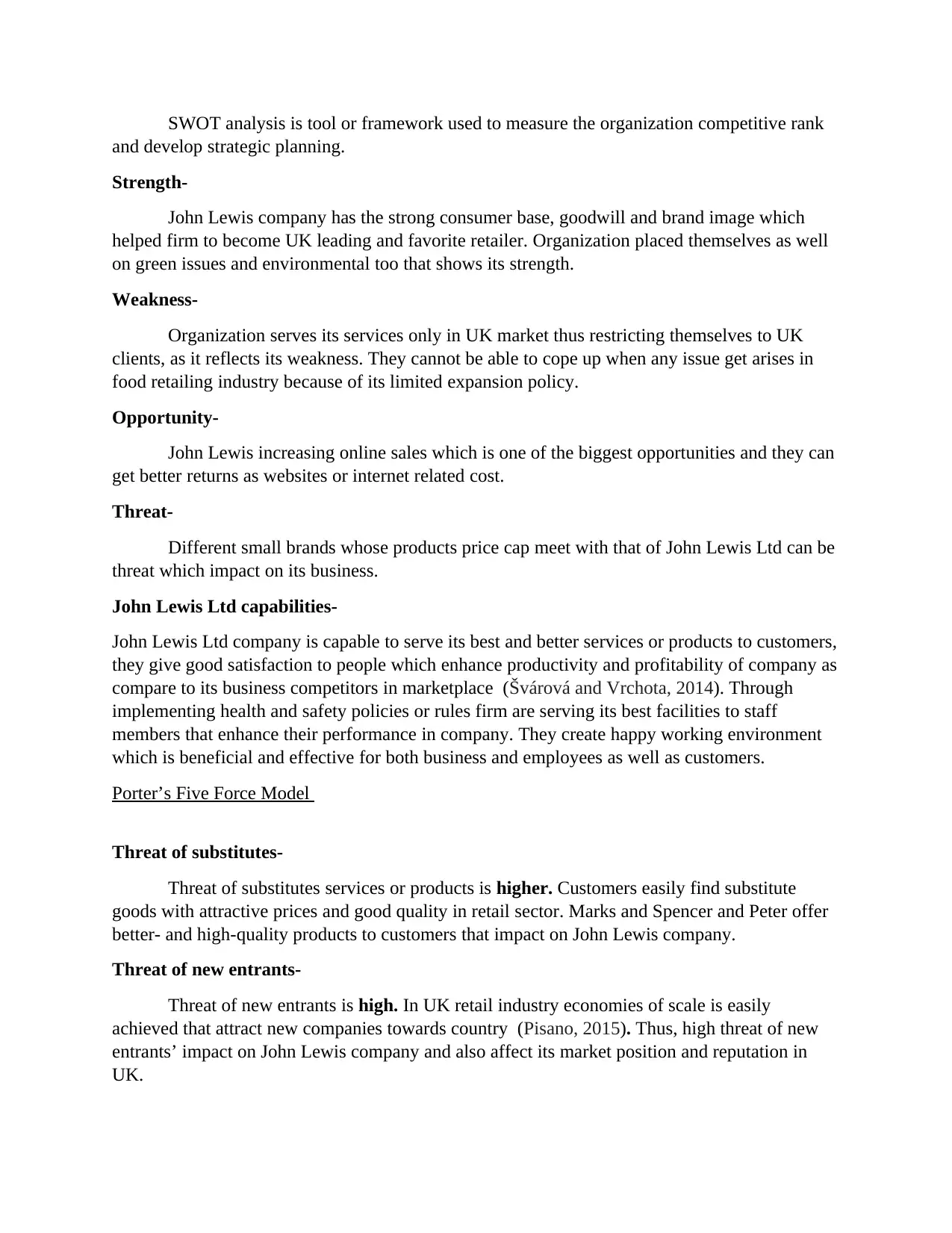
SWOT analysis is tool or framework used to measure the organization competitive rank
and develop strategic planning.
Strength-
John Lewis company has the strong consumer base, goodwill and brand image which
helped firm to become UK leading and favorite retailer. Organization placed themselves as well
on green issues and environmental too that shows its strength.
Weakness-
Organization serves its services only in UK market thus restricting themselves to UK
clients, as it reflects its weakness. They cannot be able to cope up when any issue get arises in
food retailing industry because of its limited expansion policy.
Opportunity-
John Lewis increasing online sales which is one of the biggest opportunities and they can
get better returns as websites or internet related cost.
Threat-
Different small brands whose products price cap meet with that of John Lewis Ltd can be
threat which impact on its business.
John Lewis Ltd capabilities-
John Lewis Ltd company is capable to serve its best and better services or products to customers,
they give good satisfaction to people which enhance productivity and profitability of company as
compare to its business competitors in marketplace (Švárová and Vrchota, 2014). Through
implementing health and safety policies or rules firm are serving its best facilities to staff
members that enhance their performance in company. They create happy working environment
which is beneficial and effective for both business and employees as well as customers.
Porter’s Five Force Model
Threat of substitutes-
Threat of substitutes services or products is higher. Customers easily find substitute
goods with attractive prices and good quality in retail sector. Marks and Spencer and Peter offer
better- and high-quality products to customers that impact on John Lewis company.
Threat of new entrants-
Threat of new entrants is high. In UK retail industry economies of scale is easily
achieved that attract new companies towards country (Pisano, 2015). Thus, high threat of new
entrants’ impact on John Lewis company and also affect its market position and reputation in
UK.
and develop strategic planning.
Strength-
John Lewis company has the strong consumer base, goodwill and brand image which
helped firm to become UK leading and favorite retailer. Organization placed themselves as well
on green issues and environmental too that shows its strength.
Weakness-
Organization serves its services only in UK market thus restricting themselves to UK
clients, as it reflects its weakness. They cannot be able to cope up when any issue get arises in
food retailing industry because of its limited expansion policy.
Opportunity-
John Lewis increasing online sales which is one of the biggest opportunities and they can
get better returns as websites or internet related cost.
Threat-
Different small brands whose products price cap meet with that of John Lewis Ltd can be
threat which impact on its business.
John Lewis Ltd capabilities-
John Lewis Ltd company is capable to serve its best and better services or products to customers,
they give good satisfaction to people which enhance productivity and profitability of company as
compare to its business competitors in marketplace (Švárová and Vrchota, 2014). Through
implementing health and safety policies or rules firm are serving its best facilities to staff
members that enhance their performance in company. They create happy working environment
which is beneficial and effective for both business and employees as well as customers.
Porter’s Five Force Model
Threat of substitutes-
Threat of substitutes services or products is higher. Customers easily find substitute
goods with attractive prices and good quality in retail sector. Marks and Spencer and Peter offer
better- and high-quality products to customers that impact on John Lewis company.
Threat of new entrants-
Threat of new entrants is high. In UK retail industry economies of scale is easily
achieved that attract new companies towards country (Pisano, 2015). Thus, high threat of new
entrants’ impact on John Lewis company and also affect its market position and reputation in
UK.
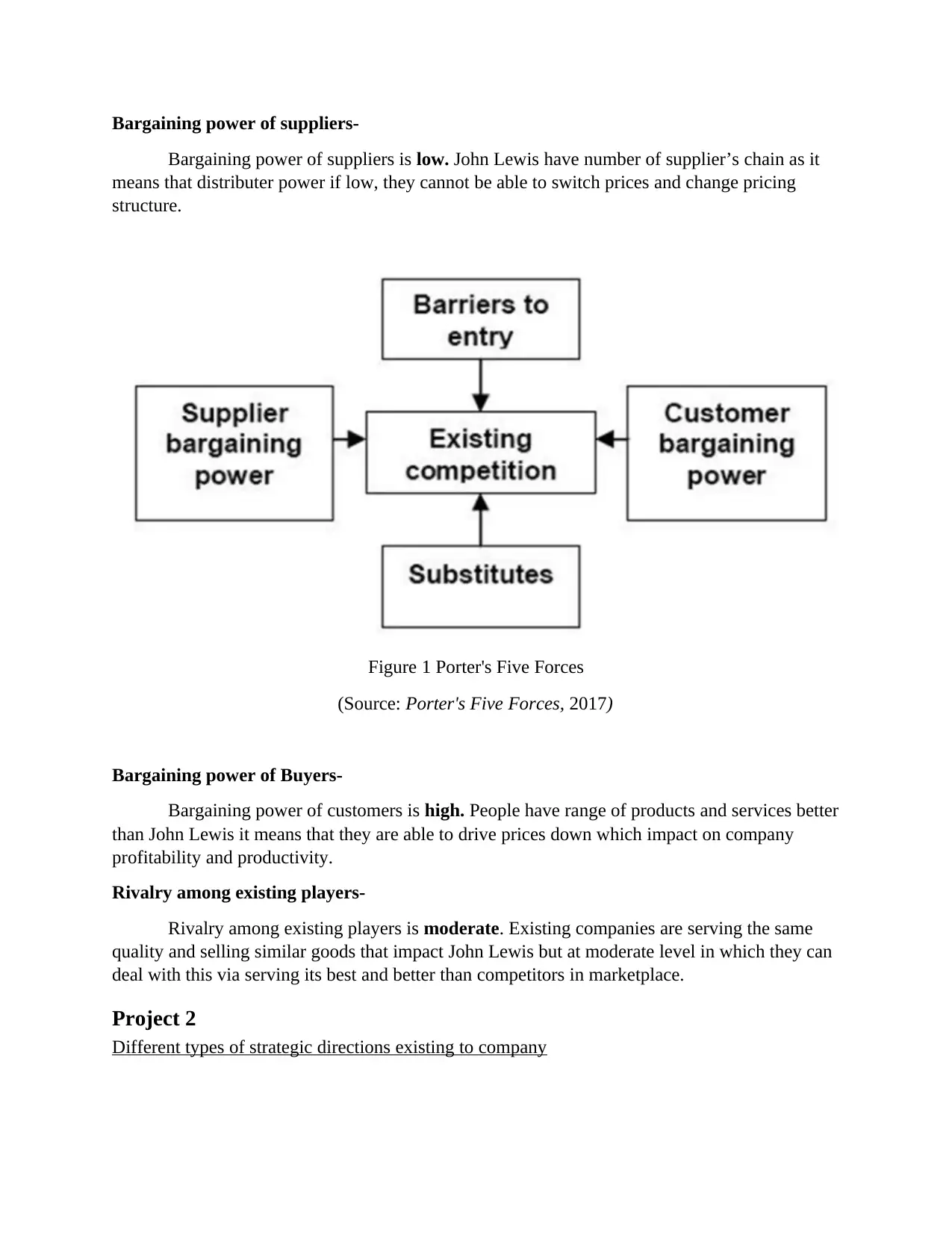
Bargaining power of suppliers-
Bargaining power of suppliers is low. John Lewis have number of supplier’s chain as it
means that distributer power if low, they cannot be able to switch prices and change pricing
structure.
Figure 1 Porter's Five Forces
(Source: Porter's Five Forces, 2017)
Bargaining power of Buyers-
Bargaining power of customers is high. People have range of products and services better
than John Lewis it means that they are able to drive prices down which impact on company
profitability and productivity.
Rivalry among existing players-
Rivalry among existing players is moderate. Existing companies are serving the same
quality and selling similar goods that impact John Lewis but at moderate level in which they can
deal with this via serving its best and better than competitors in marketplace.
Project 2
Different types of strategic directions existing to company
Bargaining power of suppliers is low. John Lewis have number of supplier’s chain as it
means that distributer power if low, they cannot be able to switch prices and change pricing
structure.
Figure 1 Porter's Five Forces
(Source: Porter's Five Forces, 2017)
Bargaining power of Buyers-
Bargaining power of customers is high. People have range of products and services better
than John Lewis it means that they are able to drive prices down which impact on company
profitability and productivity.
Rivalry among existing players-
Rivalry among existing players is moderate. Existing companies are serving the same
quality and selling similar goods that impact John Lewis but at moderate level in which they can
deal with this via serving its best and better than competitors in marketplace.
Project 2
Different types of strategic directions existing to company
⊘ This is a preview!⊘
Do you want full access?
Subscribe today to unlock all pages.

Trusted by 1+ million students worldwide
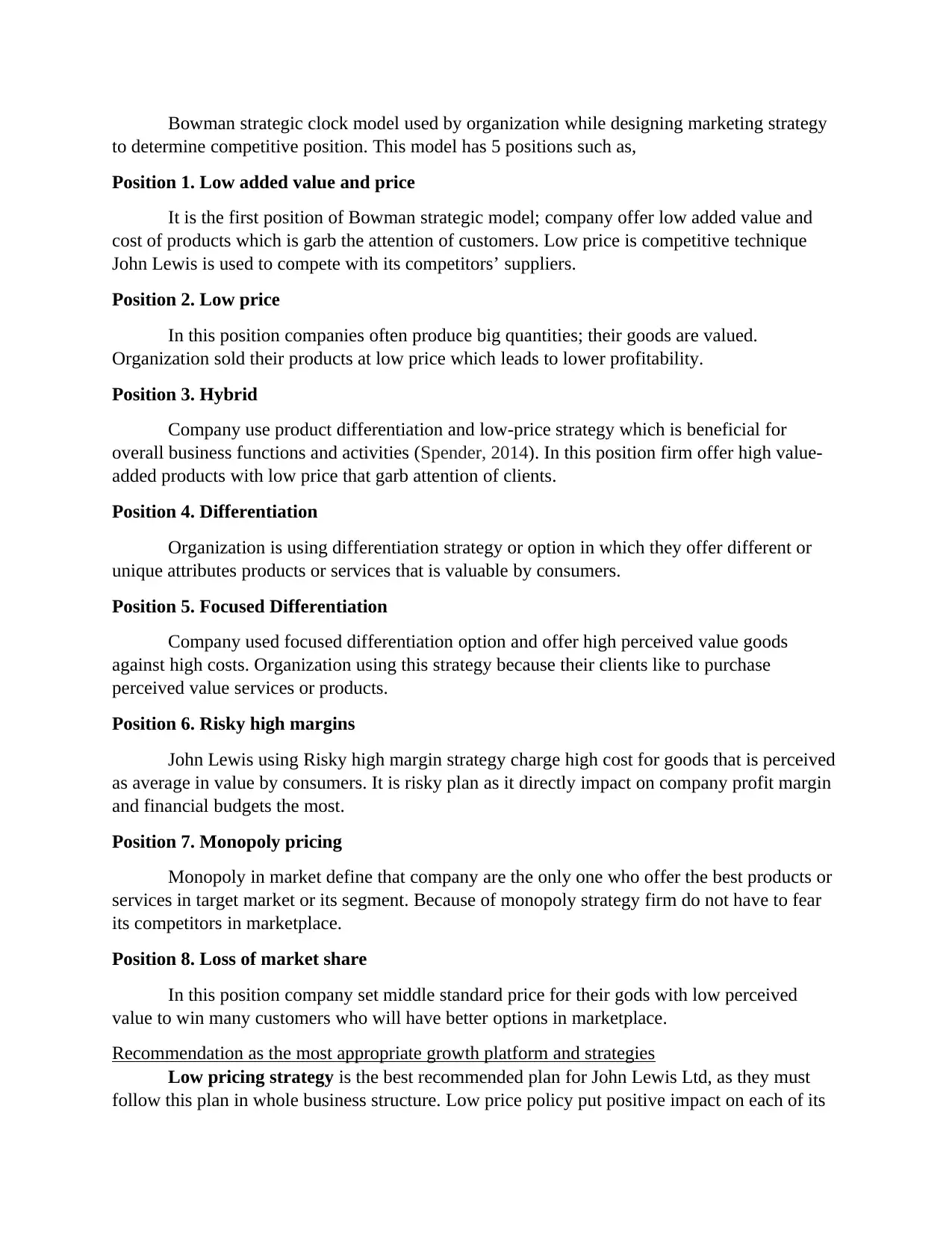
Bowman strategic clock model used by organization while designing marketing strategy
to determine competitive position. This model has 5 positions such as,
Position 1. Low added value and price
It is the first position of Bowman strategic model; company offer low added value and
cost of products which is garb the attention of customers. Low price is competitive technique
John Lewis is used to compete with its competitors’ suppliers.
Position 2. Low price
In this position companies often produce big quantities; their goods are valued.
Organization sold their products at low price which leads to lower profitability.
Position 3. Hybrid
Company use product differentiation and low-price strategy which is beneficial for
overall business functions and activities (Spender, 2014). In this position firm offer high value-
added products with low price that garb attention of clients.
Position 4. Differentiation
Organization is using differentiation strategy or option in which they offer different or
unique attributes products or services that is valuable by consumers.
Position 5. Focused Differentiation
Company used focused differentiation option and offer high perceived value goods
against high costs. Organization using this strategy because their clients like to purchase
perceived value services or products.
Position 6. Risky high margins
John Lewis using Risky high margin strategy charge high cost for goods that is perceived
as average in value by consumers. It is risky plan as it directly impact on company profit margin
and financial budgets the most.
Position 7. Monopoly pricing
Monopoly in market define that company are the only one who offer the best products or
services in target market or its segment. Because of monopoly strategy firm do not have to fear
its competitors in marketplace.
Position 8. Loss of market share
In this position company set middle standard price for their gods with low perceived
value to win many customers who will have better options in marketplace.
Recommendation as the most appropriate growth platform and strategies
Low pricing strategy is the best recommended plan for John Lewis Ltd, as they must
follow this plan in whole business structure. Low price policy put positive impact on each of its
to determine competitive position. This model has 5 positions such as,
Position 1. Low added value and price
It is the first position of Bowman strategic model; company offer low added value and
cost of products which is garb the attention of customers. Low price is competitive technique
John Lewis is used to compete with its competitors’ suppliers.
Position 2. Low price
In this position companies often produce big quantities; their goods are valued.
Organization sold their products at low price which leads to lower profitability.
Position 3. Hybrid
Company use product differentiation and low-price strategy which is beneficial for
overall business functions and activities (Spender, 2014). In this position firm offer high value-
added products with low price that garb attention of clients.
Position 4. Differentiation
Organization is using differentiation strategy or option in which they offer different or
unique attributes products or services that is valuable by consumers.
Position 5. Focused Differentiation
Company used focused differentiation option and offer high perceived value goods
against high costs. Organization using this strategy because their clients like to purchase
perceived value services or products.
Position 6. Risky high margins
John Lewis using Risky high margin strategy charge high cost for goods that is perceived
as average in value by consumers. It is risky plan as it directly impact on company profit margin
and financial budgets the most.
Position 7. Monopoly pricing
Monopoly in market define that company are the only one who offer the best products or
services in target market or its segment. Because of monopoly strategy firm do not have to fear
its competitors in marketplace.
Position 8. Loss of market share
In this position company set middle standard price for their gods with low perceived
value to win many customers who will have better options in marketplace.
Recommendation as the most appropriate growth platform and strategies
Low pricing strategy is the best recommended plan for John Lewis Ltd, as they must
follow this plan in whole business structure. Low price policy put positive impact on each of its
Paraphrase This Document
Need a fresh take? Get an instant paraphrase of this document with our AI Paraphraser
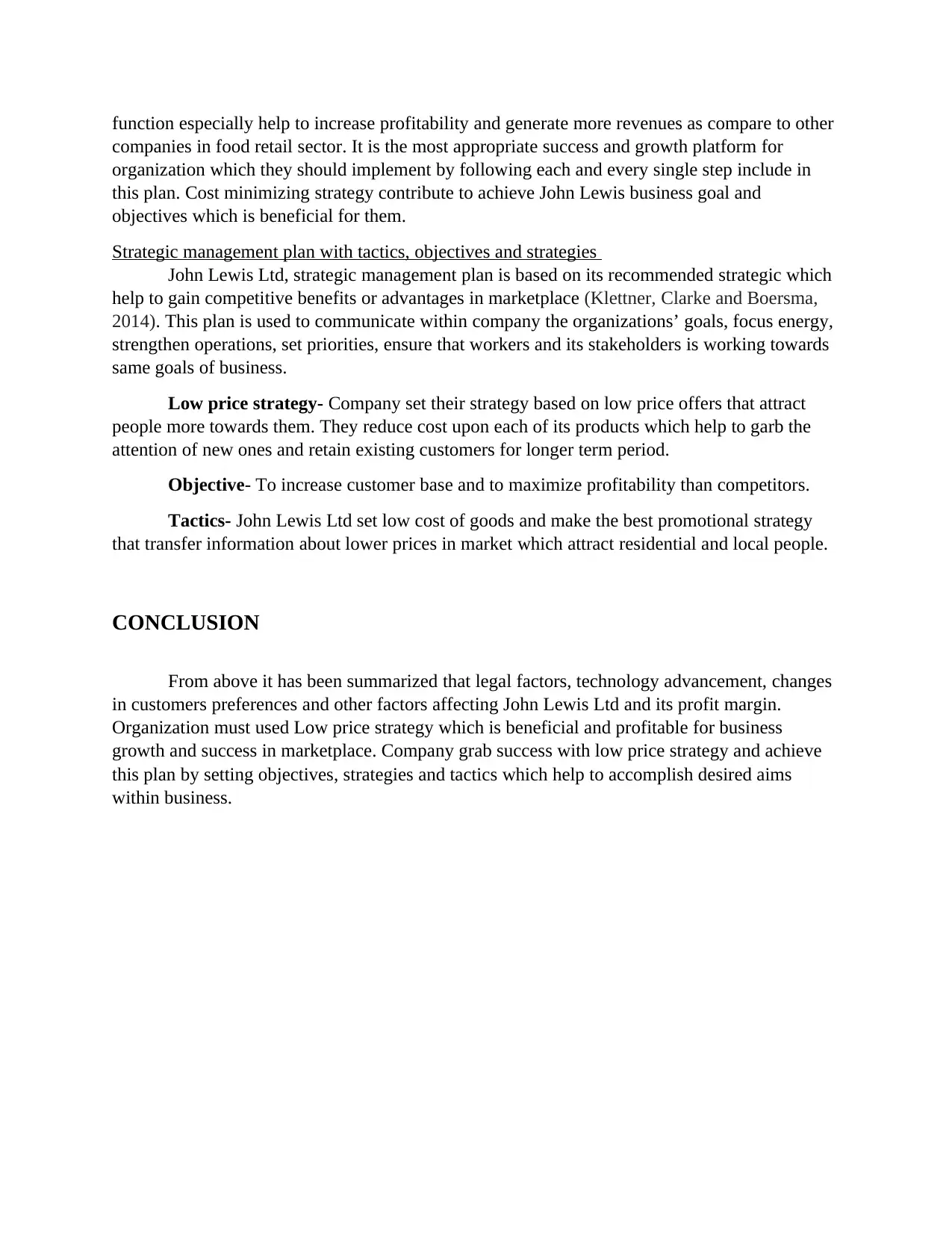
function especially help to increase profitability and generate more revenues as compare to other
companies in food retail sector. It is the most appropriate success and growth platform for
organization which they should implement by following each and every single step include in
this plan. Cost minimizing strategy contribute to achieve John Lewis business goal and
objectives which is beneficial for them.
Strategic management plan with tactics, objectives and strategies
John Lewis Ltd, strategic management plan is based on its recommended strategic which
help to gain competitive benefits or advantages in marketplace (Klettner, Clarke and Boersma,
2014). This plan is used to communicate within company the organizations’ goals, focus energy,
strengthen operations, set priorities, ensure that workers and its stakeholders is working towards
same goals of business.
Low price strategy- Company set their strategy based on low price offers that attract
people more towards them. They reduce cost upon each of its products which help to garb the
attention of new ones and retain existing customers for longer term period.
Objective- To increase customer base and to maximize profitability than competitors.
Tactics- John Lewis Ltd set low cost of goods and make the best promotional strategy
that transfer information about lower prices in market which attract residential and local people.
CONCLUSION
From above it has been summarized that legal factors, technology advancement, changes
in customers preferences and other factors affecting John Lewis Ltd and its profit margin.
Organization must used Low price strategy which is beneficial and profitable for business
growth and success in marketplace. Company grab success with low price strategy and achieve
this plan by setting objectives, strategies and tactics which help to accomplish desired aims
within business.
companies in food retail sector. It is the most appropriate success and growth platform for
organization which they should implement by following each and every single step include in
this plan. Cost minimizing strategy contribute to achieve John Lewis business goal and
objectives which is beneficial for them.
Strategic management plan with tactics, objectives and strategies
John Lewis Ltd, strategic management plan is based on its recommended strategic which
help to gain competitive benefits or advantages in marketplace (Klettner, Clarke and Boersma,
2014). This plan is used to communicate within company the organizations’ goals, focus energy,
strengthen operations, set priorities, ensure that workers and its stakeholders is working towards
same goals of business.
Low price strategy- Company set their strategy based on low price offers that attract
people more towards them. They reduce cost upon each of its products which help to garb the
attention of new ones and retain existing customers for longer term period.
Objective- To increase customer base and to maximize profitability than competitors.
Tactics- John Lewis Ltd set low cost of goods and make the best promotional strategy
that transfer information about lower prices in market which attract residential and local people.
CONCLUSION
From above it has been summarized that legal factors, technology advancement, changes
in customers preferences and other factors affecting John Lewis Ltd and its profit margin.
Organization must used Low price strategy which is beneficial and profitable for business
growth and success in marketplace. Company grab success with low price strategy and achieve
this plan by setting objectives, strategies and tactics which help to accomplish desired aims
within business.
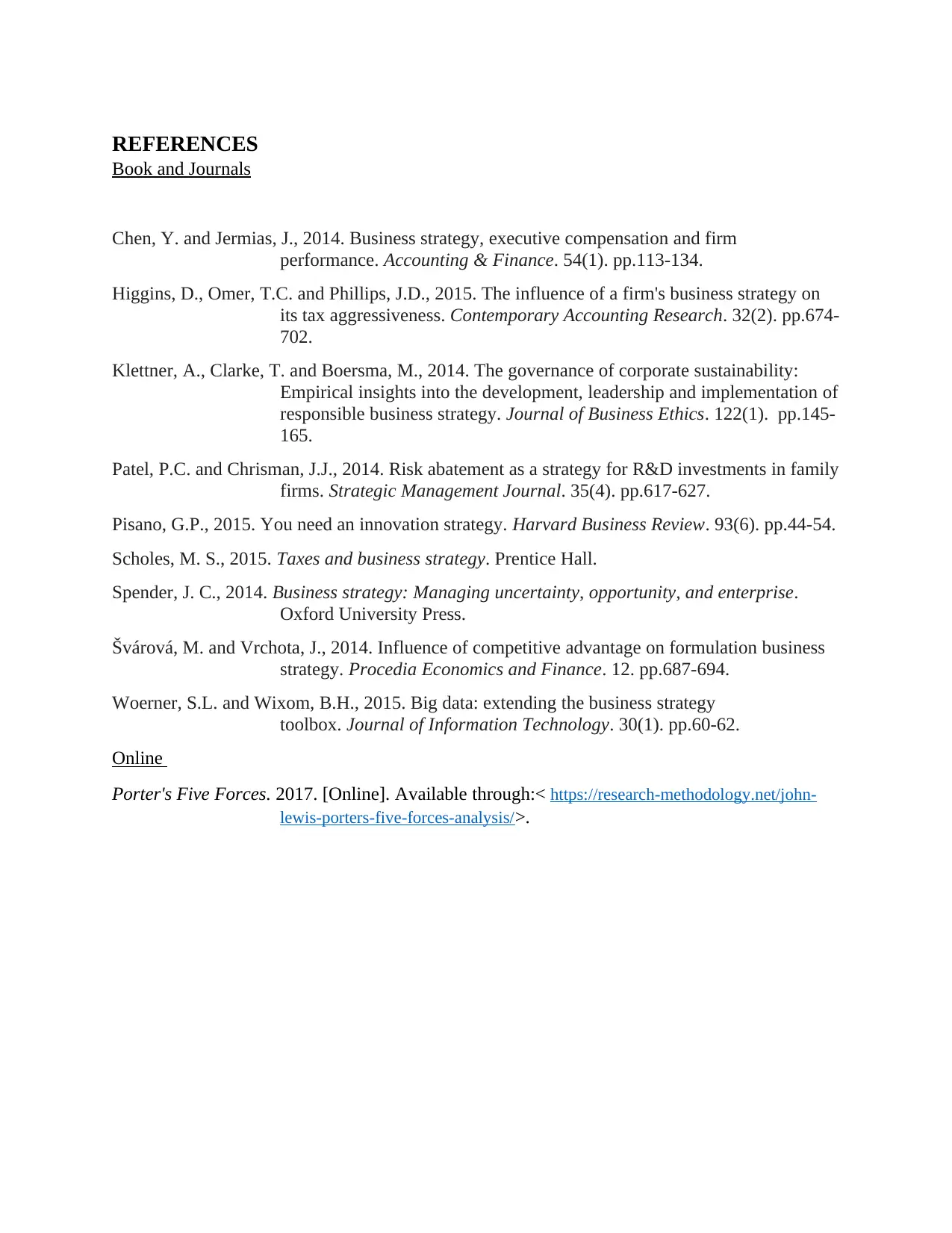
REFERENCES
Book and Journals
Chen, Y. and Jermias, J., 2014. Business strategy, executive compensation and firm
performance. Accounting & Finance. 54(1). pp.113-134.
Higgins, D., Omer, T.C. and Phillips, J.D., 2015. The influence of a firm's business strategy on
its tax aggressiveness. Contemporary Accounting Research. 32(2). pp.674-
702.
Klettner, A., Clarke, T. and Boersma, M., 2014. The governance of corporate sustainability:
Empirical insights into the development, leadership and implementation of
responsible business strategy. Journal of Business Ethics. 122(1). pp.145-
165.
Patel, P.C. and Chrisman, J.J., 2014. Risk abatement as a strategy for R&D investments in family
firms. Strategic Management Journal. 35(4). pp.617-627.
Pisano, G.P., 2015. You need an innovation strategy. Harvard Business Review. 93(6). pp.44-54.
Scholes, M. S., 2015. Taxes and business strategy. Prentice Hall.
Spender, J. C., 2014. Business strategy: Managing uncertainty, opportunity, and enterprise.
Oxford University Press.
Švárová, M. and Vrchota, J., 2014. Influence of competitive advantage on formulation business
strategy. Procedia Economics and Finance. 12. pp.687-694.
Woerner, S.L. and Wixom, B.H., 2015. Big data: extending the business strategy
toolbox. Journal of Information Technology. 30(1). pp.60-62.
Online
Porter's Five Forces. 2017. [Online]. Available through:< https://research-methodology.net/john-
lewis-porters-five-forces-analysis/>.
Book and Journals
Chen, Y. and Jermias, J., 2014. Business strategy, executive compensation and firm
performance. Accounting & Finance. 54(1). pp.113-134.
Higgins, D., Omer, T.C. and Phillips, J.D., 2015. The influence of a firm's business strategy on
its tax aggressiveness. Contemporary Accounting Research. 32(2). pp.674-
702.
Klettner, A., Clarke, T. and Boersma, M., 2014. The governance of corporate sustainability:
Empirical insights into the development, leadership and implementation of
responsible business strategy. Journal of Business Ethics. 122(1). pp.145-
165.
Patel, P.C. and Chrisman, J.J., 2014. Risk abatement as a strategy for R&D investments in family
firms. Strategic Management Journal. 35(4). pp.617-627.
Pisano, G.P., 2015. You need an innovation strategy. Harvard Business Review. 93(6). pp.44-54.
Scholes, M. S., 2015. Taxes and business strategy. Prentice Hall.
Spender, J. C., 2014. Business strategy: Managing uncertainty, opportunity, and enterprise.
Oxford University Press.
Švárová, M. and Vrchota, J., 2014. Influence of competitive advantage on formulation business
strategy. Procedia Economics and Finance. 12. pp.687-694.
Woerner, S.L. and Wixom, B.H., 2015. Big data: extending the business strategy
toolbox. Journal of Information Technology. 30(1). pp.60-62.
Online
Porter's Five Forces. 2017. [Online]. Available through:< https://research-methodology.net/john-
lewis-porters-five-forces-analysis/>.
⊘ This is a preview!⊘
Do you want full access?
Subscribe today to unlock all pages.

Trusted by 1+ million students worldwide

1 out of 10
Related Documents
Your All-in-One AI-Powered Toolkit for Academic Success.
+13062052269
info@desklib.com
Available 24*7 on WhatsApp / Email
![[object Object]](/_next/static/media/star-bottom.7253800d.svg)
Unlock your academic potential
Copyright © 2020–2025 A2Z Services. All Rights Reserved. Developed and managed by ZUCOL.




